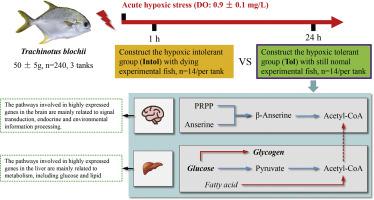Aquaculture ( IF 3.9 ) Pub Date : 2021-04-29 , DOI: 10.1016/j.aquaculture.2021.736842 Jun Long Sun , Yi Fan Liu , Tian Jiang , Yan Qiang Li , Fei Biao Song , Xin Wen , Jian Luo

|
The golden pompano (Trachinotus blochii) is becoming increasingly popular among consumers for its delicate meat and high nutritional value. High farming density, eutrophication, and high-temperature conditions increase the probability of hypoxia and thus hypoxic stress, which poses a major challenge for the future development of golden pompano aquaculture. Here, we simulated severe hypoxic stress to distinguish hypoxia-tolerant and hypoxia-sensitive individuals from hundreds of fish. We then used next-generation sequencing to analyze the mRNA expression profiles of the brains and livers under hypoxia to identify the causes of differences in hypoxia tolerance among different groups. The pathways involved in highly expressed genes in the brain were mainly related to signal transduction, endocrine function, and environmental information processing, while the pathways involved in highly expressed genes in the liver were mainly related to metabolism. Under hypoxic conditions, the degradation of liver glycogen in the hypoxia-tolerant group was inhibited under hypoxia. However, in the hypoxia-intolerant group, glycogen decomposition is not inhibited, glucose consumption increases, and there is no tendency to convert to lipid metabolism, leading to metabolic disorders. In the process of adapting to hypoxia, fish first use anaerobic glycolysis to compensate for the lack of energy due to hypoxia. However, as the stress persists, glycolysis is inhibited, and lipid metabolism becomes the preferred mode of energy metabolism; specifically, acetyl-CoA may be produced through lipid metabolism in the hypoxia-tolerant group and then participate in the tricarboxylic acid cycle to provide energy. Death in the hypoxia-intolerant group may stem from the metabolic disorder of glucose and lipid homeostasis. Although additional research is needed to confirm these possibilities, our findings suggest that converting the preferred way of energy metabolism to lipid metabolism may be a way for fish to adapt to acute hypoxic stress.
中文翻译:

金po(Trachnotus blochii)通过改变能量代谢的首选方式适应急性缺氧应激
金po参(Trachinotus blochii)以其细腻的肉和高营养价值而在消费者中越来越受欢迎。高养殖密度,富营养化和高温条件增加了缺氧的可能性,从而增加了低氧胁迫的可能性,这对金po鱼水产养殖的未来发展提出了重大挑战。在这里,我们模拟了严重的缺氧应激,以区分耐缺氧和缺氧敏感的个体与数百条鱼。然后,我们使用下一代测序技术来分析低氧条件下大脑和肝脏的mRNA表达谱,以确定不同组之间低氧耐受性差异的原因。大脑中高表达基因所涉及的途径主要与信号转导,内分泌功能和环境信息处理有关,肝脏中高表达基因所涉及的途径主要与代谢有关。在低氧条件下,低氧耐受组的肝糖原降解在低氧条件下受到抑制。但是,在不耐缺氧组中,糖原分解不受抑制,葡萄糖消耗增加,并且没有转化为脂质代谢的趋势,从而导致代谢异常。在适应缺氧的过程中,鱼类首先使用厌氧糖酵解来补偿由于缺氧引起的能量缺乏。但是,由于压力持续存在,糖酵解受到抑制,脂质代谢成为能量代谢的首选方式。具体而言,可以通过耐缺氧组中的脂质代谢产生乙酰辅酶A,然后参与三羧酸循环以提供能量。耐缺氧组的死亡可能源于葡萄糖和脂质体内稳态的代谢紊乱。尽管需要更多的研究来证实这些可能性,但我们的发现表明,将能量代谢的首选方式转换为脂质代谢可能是鱼类适应急性缺氧应激的一种方式。











































 京公网安备 11010802027423号
京公网安备 11010802027423号